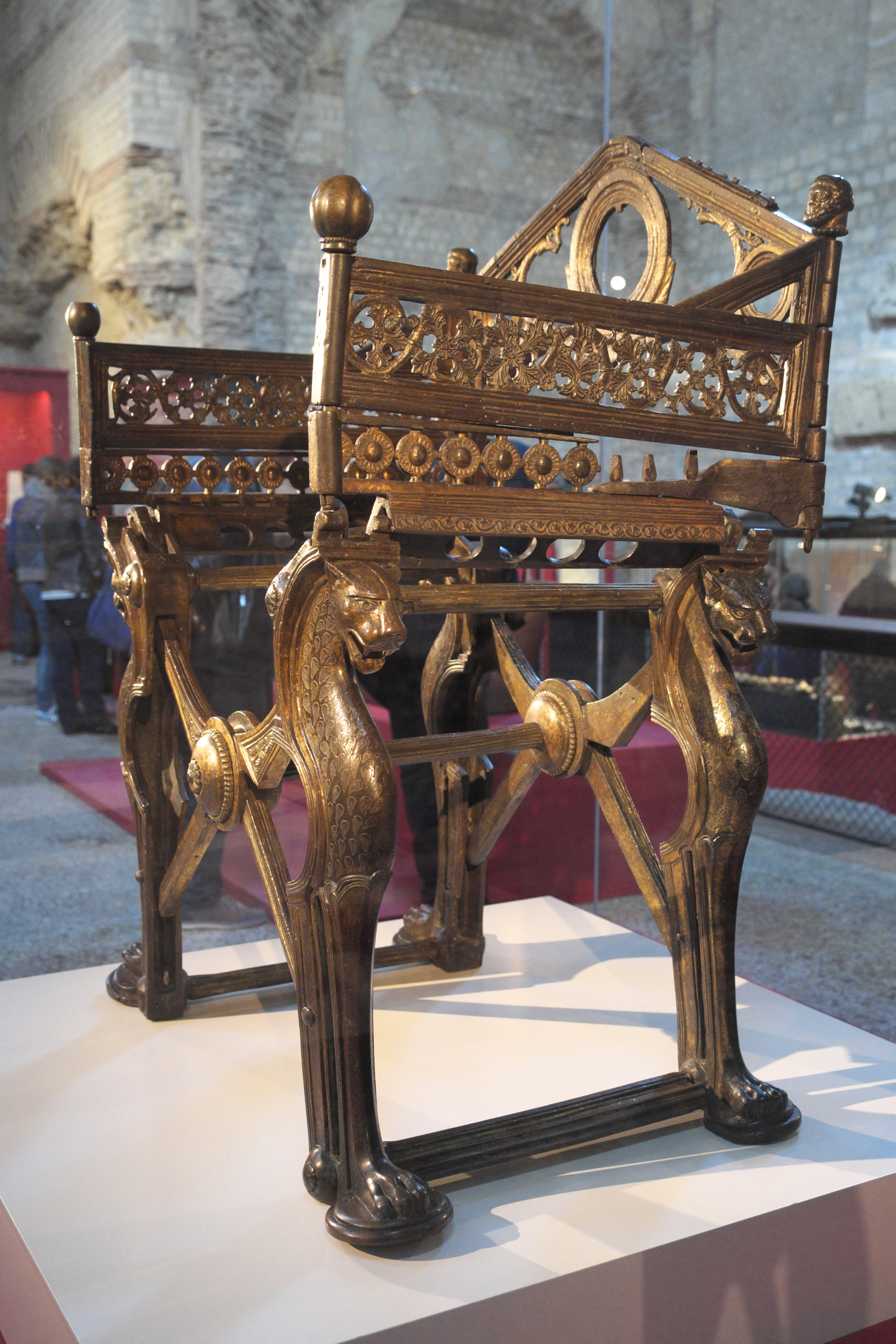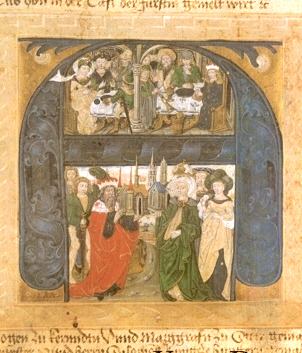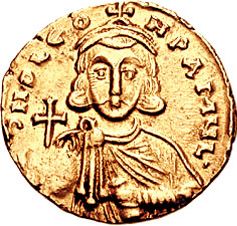|
Theodo Of Bavaria
Theodo (about 625 – 11 December c. 716), also known as Theodo V and Theodo II, was the Duke of Bavaria from 670 or, more probably, 680 to his death. It is with Theodo that the well-sourced history of Bavaria begins. He strengthened his duchy internally and externally and, according to the medieval chronicler Arbeo of Freising, he was a prince of great power whose fame extended beyond his borders. Life Theodo's descendance has not been conclusively established. A member of the Agilolfing dynasty, his father possibly was Duke Theodo IV of Bavaria (d. 680) and his mother was probably Fara of Bavaria (b. 600), daughter of one of the Kings of the Lombards and by her mother a granddaughter of Gisulf I of Friuli (b. 577). Theodo established his capital at ''Ratisbona'' (modern Regensburg). He married Folchaid, of the Frankish (possibly Robertian as the daughter of Robert II) aristocracy in Austrasia, to build diplomatic ties there. He intervened in Lombard affairs by harbouring ... [...More Info...] [...Related Items...] OR: [Wikipedia] [Google] [Baidu] |
Salzburg St Peter Gemälde Taufe 1
Salzburg (, ; literally "Salt-Castle"; bar, Soizbuag, label= Austro-Bavarian) is the fourth-largest city in Austria. In 2020, it had a population of 156,872. The town is on the site of the Roman settlement of ''Iuvavum''. Salzburg was founded as an episcopal see in 696 and became a seat of the archbishop in 798. Its main sources of income were salt extraction, trade, and gold mining. The fortress of Hohensalzburg, one of the largest medieval fortresses in Europe, dates from the 11th century. In the 17th century, Salzburg became a center of the Counter-Reformation, with monasteries and numerous Baroque churches built. Salzburg's historic center ( German: ''Altstadt'') is renowned for its Baroque architecture and is one of the best-preserved city centers north of the Alps. The historic center was enlisted as a UNESCO World Heritage Site in 1996. The city has three universities and a large population of students. Tourists also visit Salzburg to tour the historic center and t ... [...More Info...] [...Related Items...] OR: [Wikipedia] [Google] [Baidu] |
Emmeram Of Regensburg
Saint Emmeram of Regensburg (also ''Emeram(m)us'', ''Emmeran'', ''Emmerano'', ''Emeran'', ''Heimrammi'', ''Haimeran'', or ''Heimeran'') was a Christian bishop and a martyr born in Poitiers, Aquitaine. Having heard of idolatry in Bavaria, Emmeram travelled to Ratisbon (Regensburg) some time after the year 649 to the court of Theodo I, Duke of Bavaria. He supposedly travelled up the Loire, crossed through the Black Forest and then followed the Danube to Regensburg. Theodo welcomed Emmeram to his court, where he laboured for three years carrying out missionary work. During this time, he gained a reputation as a pious man. He died circa 652 and is buried in St. Emmeram's in Regensburg, Germany. His feast day in the Catholic Calendar of saints is September 22. Life Arbeo of Freising wrote a biography of Emmeram in 750, the ''Vita Sancti Emmerami'', about 100 years after the saint's death. The literature tells the story of Emmeram, born to a noble family in Aquitaine. According to ... [...More Info...] [...Related Items...] OR: [Wikipedia] [Google] [Baidu] |
Wormsgau
The Wormsgau ( la, pagus wormatiensis) was a medieval county in the East Frankish (German) stem duchy of Franconia, comprising the surroundings of the city of Worms and further territories on the left bank of the Upper Rhine river. Together with the neighbouring Nahegau and Speyergau, it belonged to the central Rhenish Franconian possessions of the Imperial Salian dynasty. Overview The Wormsgau covered large parts of the present-day Rhenish Hesse and Palatinate regions, originally stretching northwards just before Coblenz in Lotharingia. The city of Mainz belonged likewise to it as, to the start of the 9th century, also Boppard, which in reality c. 825 was already lost again. In the 10th century the Wormsgau lost extended lands in the North, mostly to the benefit of the Nahegau, like Ingelheim in 937, Spiesheim in 960, Saulheim in 973 and Flonheim in 996, until the Selz river defined the northern border. The losses could be partially compensated through expansion up the Rhine and ... [...More Info...] [...Related Items...] OR: [Wikipedia] [Google] [Baidu] |
St Peter's Abbey, Salzburg
St Peter's Abbey (german: Stift Sankt Peter), or St Peter's Archabbey (German: ''Erzabtei Stift Sankt Peter'', la, Archiabbatia sancti Petri Salisburgensis), is a Benedictine monastery and former cathedral in the Austrian city of Salzburg. It is considered one of the oldest monasteries in the German-speaking area, and in fact the oldest with a continuous history since its foundation in 696. History St Peter's Abbey was founded in 696 by Saint Rupert at the site of a Late Antique church stemming from the first Christianization in the area in the days of Severinus of Noricum. Likewise the establishment of the monastery was meant to advance missionary efforts in the Eastern Alps. Until 987, the office of the abbot was joined to that of the Archbishop of Salzburg: one man fulfilled both duties. In the Middle Ages, St Peter's was known for its exceptional school. In 1074, Archbishop Gebhard of Salzburg sent several monks to found Admont Abbey in the March of Styria. In the 15th cen ... [...More Info...] [...Related Items...] OR: [Wikipedia] [Google] [Baidu] |
Verbrüderungsbuch
A confraternity book (german: Verbrüderungsbuch, la, liber confraternitatum or ''confraternitatis''), also called a ''liber memorialis'' (memorial book) or ''liber vitae'' (book of life), is a medieval register of the names of people who had entered into a state of spiritual brotherhood (confraternity) with a church or monastery in some way, often by visiting it in the capacity of a pilgrim. Persons named in such a book were actively remembered in the prayers of the priests or monks. In many cases these books were established as early as the 8th century and continued up to the 13th century. So-called '' Jahrtagsbücher'' (year books) are in many ways their successors. Confraternity books are a rich source for prosopography and historical linguistics of the early Middle Ages. List of confraternity books The following is a list of some earlier medieval confraternity books: * Confraternity book of the Abbey of Saint Gall * Confraternity book of Reichenau Abbey * Confraternity book ... [...More Info...] [...Related Items...] OR: [Wikipedia] [Google] [Baidu] |
Dagobert I
Dagobert I ( la, Dagobertus; 605/603 – 19 January 639 AD) was the king of Austrasia (623–634), king of all the Franks (629–634), and king of Neustria and Burgundy (629–639). He has been described as the last king of the Merovingian dynasty to wield any real royal power. Dagobert was the first of the Frankish kings to be buried in the royal tombs at Saint Denis Basilica. Rule in Austrasia Dagobert was the eldest son of Chlothar II and Haldetrude (575–604) and the grandson of Fredegund. Chlothar had reigned alone over all the Franks since 613. In 622, Chlothar made Dagobert king of Austrasia, almost certainly to bind the Austrasian nobility to the ruling Franks. As a child, Dagobert lived under the care of the Carolingian dynasty forebears and Austrasian magnates, Arnulf of Metz and Pepin of Landen. Chlothar attempted to manage the unstable alliances he had with other noble families throughout much of Dagobert's reign. When Chlothar granted Austrasia to Dagobert, he ... [...More Info...] [...Related Items...] OR: [Wikipedia] [Google] [Baidu] |
Regintrud
Regintrud, also known as Reginlind and Regentrud, (born 660–665,Note: the provided date of birth would be invalid if she is Dagobert I's daughter as he died 639 died 730–740) was probably the wife of Duke Theodbert of Bavaria or of his father Duke Theodo of Bavaria."Regintrud (fl. 8th c.)." ''Dictionary of Women Worldwide: 25,000 Women Through the Ages'', edited by Anne Commire and Deborah Klezmer, vol. 2, Yorkin Publications, 2007, p. 1578. ''Gale eBooks'', link.gale.com/apps/doc/CX2588819765/GVRL?u=wikipedia&sid=GVRL&xid=021c51f6. Accessed 13 Apr. 2021. A possibly identical ''Regintrud'' became abbess of Nonnberg Abbey in 720–725. However, details about her ancestry and life are widely disputed among historians. According to differing views, Regintrud was either a daughter of King Dagobert I, or of Pfalzgraf Hugobert and Irmina of Oeren, or of Childebert III. Issue Assuming she was married with Theudebert of Bavaria, her children from this marriage were: * Hugbert of Bava ... [...More Info...] [...Related Items...] OR: [Wikipedia] [Google] [Baidu] |
Johannes Aventinus
Johann Georg Turmair (or Thurmayr) (4 July 1477 – 9 January 1534), known by the pen name Johannes Aventinus (Latin for "John of Abensberg") or Aventin, was a Bavarian Renaissance humanist historian and philologist. He authored the 1523 ''Annals of Bavaria'', a valuable record of the early history of Germany.James Wood, ed.''The Nuttall Encyclopædia'' 1907; a modern biography in English is G. Strauss, ''Historian in an age of crisis: the life and work of Johannes Aventinus, 1477-1534'', 1963. Tutor Having studied at Ingolstadt, Vienna, Cracow and Paris, he returned to Ingolstadt in 1507 and in 1509 was appointed tutor to Louis and Ernest, the two younger brothers of William IV, Duke of Bavaria, all three the sons of Albert the Wise, the late duke of Bavaria. Aventinus retained this position until 1517, wrote a Latin grammar (''Rudimenta grammaticae latinae''; 1512) and other manuals for the use of his pupils, and in 1515 travelled in Italy with Ernest. In his zeal fo ... [...More Info...] [...Related Items...] OR: [Wikipedia] [Google] [Baidu] |
Ladislaus Sunthaym
Ladislaus Sunthaym (''Sunthaym, Sunthaim, Sunthain, Sunthaymer'', born c. 1440 in Ravensburg, died 1512 or 1513 in Vienna) was a German historian, genealogist and geographer. He studied theology in Vienna and was elected "procurator of the Rhenish nation" (a kind of association of students from the Rhineland in Vienna) in 1460. He received his degree of ''Baccalaureus artium'' in 1465 and acted as a priest in Vienna from 1473. The abbot of Klosterneuburg in 1485 asked Sunthaym to compile a family history of Leopold III, Margrave of Austria in connection with the margrave's canonization. Sunthaym worked on a history and genealogy of the Babenberg family until 1489, perusing the histories of Otto von Freising and Thomas Ebendorfer. The finished work was exhibited in Klosterneuburg abbey as a richly illuminated parchment manuscript, the so-called ''Tabulae Claustroneoburgenses''. The manuscript was supplemented by a great triptych based on the Babenberg family tree, made by the work ... [...More Info...] [...Related Items...] OR: [Wikipedia] [Google] [Baidu] |
Renaissance
The Renaissance ( , ) , from , with the same meanings. is a period in European history The history of Europe is traditionally divided into four time periods: prehistoric Europe (prior to about 800 BC), classical antiquity (800 BC to AD 500), the Middle Ages (AD 500 to AD 1500), and the modern era (since AD 1500). The first early ... marking the transition from the Middle Ages to modernity and covering the 15th and 16th centuries, characterized by an effort to revive and surpass ideas and achievements of classical antiquity. It occurred after the Crisis of the Late Middle Ages and was associated with great social change. In addition to the standard periodization, proponents of a "long Renaissance" may put its beginning in the 14th century and its end in the 17th century. The traditional view focuses more on the Early modern period, early modern aspects of the Renaissance and argues that it was a break from the past, but many historians today focus more on its medieval a ... [...More Info...] [...Related Items...] OR: [Wikipedia] [Google] [Baidu] |
Lantpert
Lantpert (or ''Landbert'' or ''Landfried'') (born before 636, died after 680) was the son of Theodo, duke of Bavaria, and Gleisnot of Friuli. According to the ''Vita Hamhrammi'' by Arbeo, bishop of Freising, Lantpert is the murderer of the Saint Emmerambr> Emmeram had been a guest of the ducal court for three years, where he was known for his chaste and pure lifestyle. Uta, daughter of Duke Theodo and sister to Lantpert, had become pregnant by her lover. Fearing her father's wrath, she confided to Emmeram and the saint promised bear the blame, as he was about to travel to Rome. Soon after his departure, Uta's predicament became known and in keeping with the agreement she named Emmeram the father. Lantpert went after Emmeram and greeted him as "bishop and brother-in-law" (''Aie, episcope et gener noster!'') Then he had Emmeram cut and torn into pieces. Nothing more is known of Lantpert and his sister Uta. Lantpert's deed might be the cause for the Lex Baiuvariorum The ''Lex ... [...More Info...] [...Related Items...] OR: [Wikipedia] [Google] [Baidu] |
Pope Gregory II
Pope Gregory II ( la, Gregorius II; 669 – 11 February 731) was the bishop of Rome from 19 May 715 to his death.Mann, Horace. "Pope St. Gregory II." The Catholic Encyclopedia Vol. 6. New York: Robert Appleton Company, 1909. 18 September 2017 His defiance of Emperor as a result of the iconoclastic controversy in the Eastern Empire prepared the way for a long series of revolts, schisms, and civil wars that eventually led to the establishment of the [...More Info...] [...Related Items...] OR: [Wikipedia] [Google] [Baidu] |


_1000.png)



